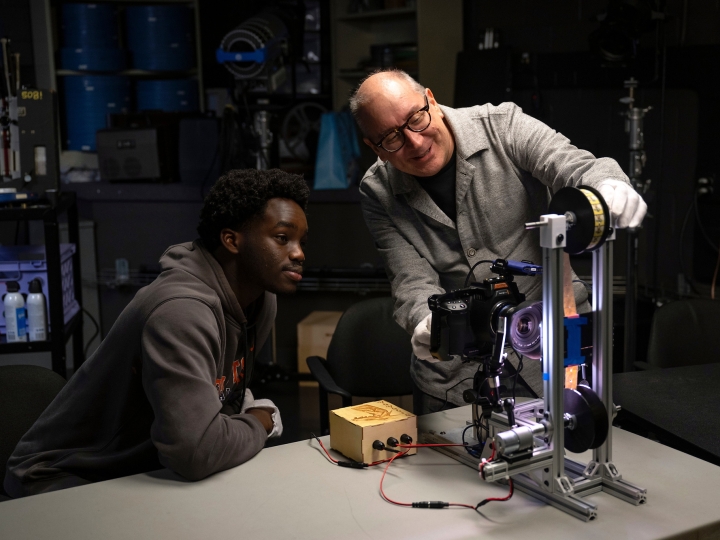
Solving for Industry: Bucknell’s New Math
April 22, 2019
Photo by Emily Paine, Communications
If you tried to picture a group of math students working on a research project alongside their professor, what would you see? People at a computer watching columns of numbers fly by? Or maybe filling a whiteboard with graphs and equations?
Across campus, Bucknell students engage in all kinds of research opportunities with their professors. In the Department of Mathematics, the work is often more theory, less something you can see and touch — but that's not always the case.
Learn more about applying to Bucknell
Students enrolled in Bucknell's new Mathematics 219: Solving Industrial Problems course are crunching data, for sure, but you'll also find them on a downtown Lewisburg street scouting options for a new bus route. Or giving a demonstration to a room full of professionals. These students are being asked to not only quantify information, but also to qualify it.
"What's different about this course," said Professor Nathan Ryan, "is that it's all applied. With grant funding from PIC Math, a program funded by the Mathematical Association of America and the National Science Foundation, our department has designed a class that's outside the classroom. No lectures, no quizzes or tests." What it looks like is graduate school, yet these are undergraduate juniors and seniors.
The reason I took this class is the fact that we are going to make a difference.
Zachary Feit ’20
Zachary Feit '20 and his three teammates are consulting for Joanne Troutman, president and CEO of Greater Susquehanna Valley United Way, in collaboration with the Central Pennsylvania Transportation Coalition. The organizations are considering the implementation of a bus system in the Greater Susquehanna Valley, and approached Bucknell to model potential routes and carry out related statistical analyses. "We needed students who are incredibly smart, able to dive deep into multiple pieces of the project and present professionally," said Troutman. Students were asked to determine a public bus route that optimizes timing and ridership.
"Right now there are people who have to walk miles or wait hours for a ride to work or appointments," said Feit, a mathematics major from Livingston, N.J. "The reason I took this class is the fact that we are going to make a difference."
That kind of experiential learning also appealed to his friend, Elise Covert '20, an applied mathematical sciences major from Kennett Square, Pa., who has a passion for the psychology and human side of numbers. She and Feit recruited classmates Megan Fournier '19, a global management major and mathematics minor from Kennett Square, Pa., and Alexandra Koumas '20, a mathematics major from Huntington, N.Y., and the four approached the course like job applicants. They pitched a compelling case for working together on the United Way project and got the assignment.
It's been a dream team. "Elise is a very professional writer and editor," said Feit. "Alex is really good at research, and Megan is fantastic at pulling all of the information together and compiling it all into a report."
"And Zack," said Covert, "is really good at ArcGIS, an interactive mapping software that allows us to integrate and visualize all of our data."
In an early presentation to United Way and the Coalition, "We demonstrated how we mapped the route and stops, and presented them with our conclusion that two buses would not be enough," said Covert. "They had done preliminary assessments that showed need, but they needed detailed statistical backup." The Bucknell team more than came through.
"When the students presented their findings, we were blown away by the level of information they provided," said Troutman, who underscored the importance of the project. "It's going to change lives."
That's a pretty gratifying deliverable, and one of several these students will take away from the course.
"As math students," said Feit, "our team is learning different ways of thinking about how to approach a problem. And how to make a difference."

